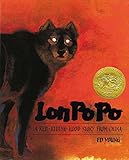The Solution to Reading Comprehension
Lessons & Units :: Lon Po Po 3rd Grade Unit
Paired Text Questions: Lon Po Po & "A Tricky Monkey"
Lesson Plan
Lon Po Po: A Red-Riding Hood Story from China | 670L

- Learning Goal
- Integrate information from the fiction passage “A Tricky Monkey” and the book Lon Po Po to write and speak about the topic of deception.
- Duration
- Approximately 20 minutes
- Necessary Materials
- Provided:
- Questions
- Fiction reading passage “A Tricky Monkey”
Not Provided:
Lon Po Po
- Questions 1 and 2 refer to the fiction passage “A Tricky Monkey.” Questions 3 and 4 refer to the book Lon Po Po. Questions 5 and 6 refer to both the passage and the book.
- Student versions of the questions are in the 'Texts & Materials' tab.
Part 1: “A Tricky Monkey”
Read the passage “A Tricky Monkey” out loud to your students. Alternatively, students can read the passage independently or as a group.
Question 1: What trick did Kojo the monkey decide to play on the other monkeys?
Sample student answer: Kojo the monkey tricked the other monkeys into thinking that a leopard was coming.
Question 2: What happened the third time Kojo warned the other monkeys about a leopard?
Sample student answer: Even though there was a real leopard this time, the other monkeys no longer believed Kojo. The other monkeys thought Kojo was lying again.
Part 2: Lon Po Po
Question 3: What lie did Shang tell the wolf?
Sample student answer: Shang told the wolf that tasting a gingko nut would make him live forever.
Question 4: Why did Shang tell this lie?
Sample student answer:
- Shang told this lie to save herself and her sisters from the wolf.
- Shang told this lie so that she and her sisters could escape from the wolf and kill him.
Part 3: “A Tricky Monkey” and Lon Po Po
Question 5: What do Kojo and Shang have in common?
Sample student answer: They both told lies.
Question 6: Is tricking others a good thing or a bad thing? Use "A Tricky Monkey" and Lon Po Po to support your answer.
Sample student answer (will vary but may include):
- Tricking others is a bad thing because others may be less likely to believe someone who is not truthful, especially when it really matters, as was the case with Kojo.
- Tricking others is a good thing because it may help someone get out of a dangerous situation, as happened with Shang and her sisters.
- Tricking others may be bad or good. Whether a trick is bad or good has to do with the reason for doing it. For example, Kojo did not have a very good reason for tricking the other monkeys, and they ended up not believing him when he was actually telling the truth. But Shang was able to save herself and her sisters by tricking the wolf.
Texts & Materials
Standards Alignment
(To see all of the ReadWorks lessons aligned to your standards, click here.)



Thank you! I will use the story this week.
So excited to use this with my students.
Thank you!
I'm looking forward to teach this lesson this week. Thanks
Love the story!!! Thanks for making Benchmark Interventions planning easier. My students loved the story!!!
I am eager to try the lesson out!
I love it so much thank you
I am eager to do this lesson with the extra story. I have done Lon Po Po for several years out of my basal reader.
This was a great lesson. Similar content to the administered MOSL at the beginning of the year using paired passages.